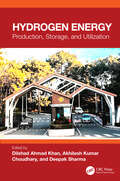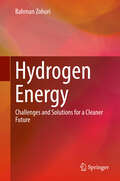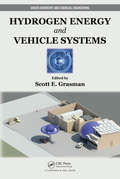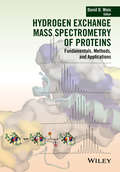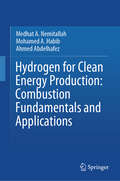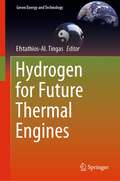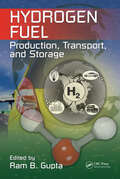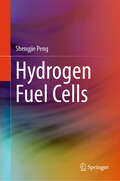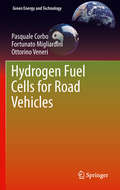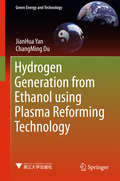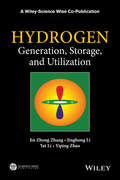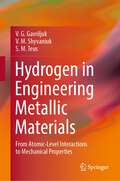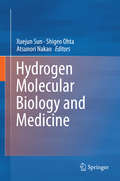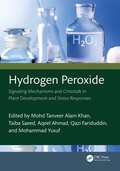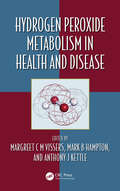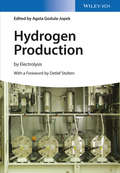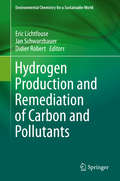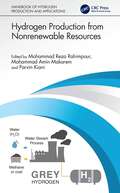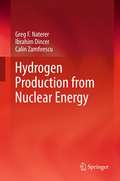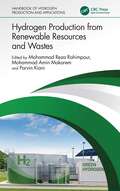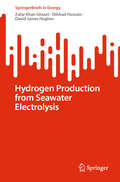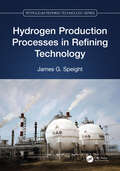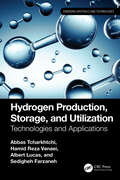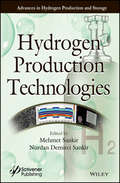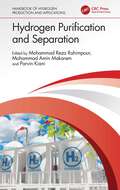- Table View
- List View
Hydrogen Energy: Production, Storage and Utilization
by Dilshad Ahmad Khan, Akhilesh Kumar Choudhary, and Deepak SharmaSince the low energy efficiency and rise in emissions by using fossil fuels, the hydrogen economy has been considered as a unique approach to resolve these problems, making hydrogen an attractive fuel. This book titled Hydrogen Energy: Production, Storage, and Utilization describes various technologies for hydrogen production from different sources and storage in liquid, gaseous, and compound forms, which have also been covered in detail. It also highlights the various modes of transportation of hydrogen and its utilization in a variety of engineering applications such as automotive engines, fuel cells, electric power generation, and aerospace. The book also explores the safety challenges, handling issues, and future scope.This book: Covers the methods of hydrogen production including the bioconversion method. Explains the hydrogen storage technologies with proper illustrations. Includes engineering and non-engineering applications of hydrogen utilization covering the most advanced generation of fuel cells, power generation for hybrid vehicles, and space applications. Presents state-of-the-art research carried out in the domains of hydrogen production, storage, transportation, and utilization along with safety aspects. Discusses modes and methods of hydrogen transportation such as in gaseous form, liquid form, and solid form. The book has a wide scope of reaching out to diverse readers including but not limited to industrial engineers, process engineers, researchers, and academicians. The research fraternity will gain the benefit of being aware and selecting a similar recent research domain in the field of hydrogen production.
Hydrogen Energy: Challenges and Solutions for a Cleaner Future
by Bahman ZohuriThis book describes the challenges and solutions the energy sector faces by shifting towards a hydrogen based fuel economy. The most current and up-to-date efforts of countries and leaders in the automotive sector are reviewed as they strive to develop technology and find solutions to production, storage, and distribution challenges. Hydrogen fuel is a zero-emission fuel when burned with oxygen and is often used with electrochemical cells, or combustion in internal engines, to power vehicles and electric devices. This book offers unique solutions to integrating renewable sources of energy like wind or solar power into the production of hydrogen fuel, making it a cost effective, efficient and truly renewable alternative fuel.
Hydrogen Energy and Vehicle Systems (Green Chemistry and Chemical Engineering)
by Scott E. GrasmanWith contributions from noted laboratory scientists, professors, and engineers, Hydrogen Energy and Vehicle Systems presents a new comprehensive approach for applying hydrogen-based technologies to the transportation and electric power generation sectors. It shows how these technologies can improve the efficiency and reliability of energy and trans
Hydrogen Exchange Mass Spectrometry of Proteins
by David D. WeisHydrogen exchange mass spectrometry is widely recognized for its ability to probe the structure and dynamics of proteins. The application of this technique is becoming widespread due to its versatility for providing structural information about challenging biological macromolecules such as antibodies, flexible proteins and glycoproteins. Although the technique has been around for 25 years, this is the first definitive book devoted entirely to the topic. Hydrogen Exchange Mass Spectrometry of Proteins: Fundamentals, Methods and Applications brings into one comprehensive volume the theory, instrumentation and applications of Hydrogen Exchange Mass Spectrometry (HX-MS) - a technique relevant to bioanalytical chemistry, protein science and pharmaceuticals. The book provides a solid foundation in the basics of the technique and data interpretation to inform readers of current research in the method, and provides illustrative examples of its use in bio- and pharmaceutical chemistry and biophysics In-depth chapters on the fundamental theory of hydrogen exchange, and tutorial chapters on measurement and data analysis provide the essential background for those ready to adopt HX-MS. Expert users may advance their current understanding through chapters on methods including membrane protein analysis, alternative proteases, millisecond hydrogen exchange, top-down mass spectrometry, histidine exchange and method validation. All readers can explore the diversity of HX-MS applications in areas such as ligand binding, membrane proteins, drug discovery, therapeutic protein formulation, biocomparability, and intrinsically disordered proteins.
Hydrogen for Clean Energy Production: Combustion Fundamentals and Applications
by Medhat A. Nemitallah Mohamed A. Habib Ahmed AbdelhafezThe book fills the existing gap in the literature on clean and hydrogen combustion technologies for industrial applications. This gas is created due to the absence of a comprehensive textbook that covers such kinds of developments. This book can be used as a textbook for graduate-level courses in the areas of clean and hydrogen combustion and as a reference book for short courses to be offered to mechanical and aerospace engineers and young researchers worldwide. The book chapters consider investigating clean and hydrogen combustion techniques for different applications based on experimental measurements along with detailed numerical simulations. Detailed descriptions of the different numerical models are presented for given applications to solve for the flow/flame fields, which are very important, especially for beginners and undergraduate students in the fields of clean and hydrogen combustion.
Hydrogen for Future Thermal Engines (Green Energy and Technology)
by Efstathios-Al. TingasThis book explores the potential of hydrogen combustion in thermal engines and serves as a foundation for future research.Hydrogen, a well-established energy carrier, has been used in internal combustion engines for centuries, but despite progress and industry interest, hydrogen engines have yet to reach mass production. In light of recent efforts to combat climate change with clean energy and environmentally-friendly technologies, the use of hydrogen in thermal engines is gaining momentum.This book examines the unique challenges of hydrogen combustion due to its wide flammability limits, high auto-ignition temperature, and high diffusivity. It reviews current knowledge on the fundamental and practical aspects of hydrogen combustion and considers current developments and potential future advancement.
Hydrogen Fuel: Production, Transport, and Storage
by Ram B. GuptaFrom Methane to Hydrogen-Making the Switch to a Cleaner Fuel Source The world's overdependence on fossil fuels has created environmental problems, such as air pollution and global warming, as well as political and economic unrest. With water as its only by-product and its availability in all parts of the world, hydrogen promises to be the next grea
Hydrogen Fuel Cells
by Shengjie PengThis book introduces in detail the different types of hydrogen fuel cells, including alkaline fuel cells, proton exchange membrane fuel cells, solid oxide fuel cells, phosphate fuel cells, molten carbonate fuel cells, direct liquid fuel cells, etc., and discusses their operating principles, performance characteristics and application fields in depth. Readers will be able to comprehensively understand the current status and future development trends of fuel cell technology to provide technical support for hydrogen energy applications. The last two chapters of the book also introduce the automotive application and development of alkaline fuel cells, and the application of hydrogen-powered transportation equipment in the field of national defense. This book is not only suitable as a teaching material or teaching reference book for senior undergraduate and graduate students of relevant majors in colleges and universities, but also suitable for scientific and technological workers engaged in scientific research and technology research and development of new energy materials and devices and related fields.
Hydrogen Fuel Cells for Road Vehicles
by Pasquale Corbo Fortunato Migliardini Ottorino VeneriHydrogen Fuel Cells for Road Vehicles addresses the main issues related to the application of hydrogen fuel cell technology in the road transportation sector. A preliminary treatment is given on fuel resources and atmospheric pollution concerns which are closely related to the current technology (internal combustion engine) used for moving people and goods. The authors deal, in particular, with the problems that can hinder a widespread hydrogen market (production, storage and distribution), as well as giving an analysis of fuel cell technologies available for utilization of this energy carrier in the automotive field. Hydrogen Fuel Cells for Road Vehicles also examines the concerns faced during the design and realization of a PEM fuel cell system with optimal size and efficiency, evidencing the impact of the individual auxiliary components on energy losses and dynamic stack performance. The book ends with the analysis of two practical case studies on fuel cell propulsion systems. Hydrogen Fuel Cells for Road Vehicles is a useful text for researchers, professionals and advanced students in the fields of automotive and environmental engineering.
Hydrogen Generation from Ethanol using Plasma Reforming Technology
by Jianhua Yan Changming DuThis book provides an overview of hydrogen production from renewable resources such as ethanol using plasma or plasma-catalytic technologies. Further, it presents a balanced and comprehensive treatment of the core principles, novel plasma reactors and diagnostics, as well as state-of-the-art plasma energy applications. It brings together technological advances and research on plasma generators and their application in hydrogen production, including plasma-assisted alcohol reforming technology, plasma-catalytic alcohol reforming technology, the alcohol reforming mechanism, models of alcohol reforming for hydrogen production, the energy balance of hydrogen production from ethanol, and a comparison of alcohol reforming assisted by different plasma treatment systems. As such, it offers a valuable reference guide for scientists, engineers and graduate students in the fields of energy and environment, plasma physics and chemistry.
Hydrogen Generation, Storage and Utilization
by Yiping Zhao Jinghong Li Jin Zhong Zhang Yat LiAddresses the three fundamental aspects of hydrogen as a fuel resource: generation, storage, and utilizationProvides theoretical basis for the chemical processes required for hydrogen generation, including solar, photoelectrochemical, thermochemical, and fermentation methodsDiscusses storage of hydrogen based on metal hydrides, hydrocarbons, high pressure compression, and cryogenicsExamines the applications of hydrogen utilization in the fields of petroleum, chemical, metallurgical, physics, and manufacturingContains over 90 figures, including 27 color figures
Hydrogen in Engineering Metallic Materials: From Atomic-Level Interactions to Mechanical Properties
by V. G. Gavriljuk V. M. Shyvaniuk S. M. TeusThis book analyzes the effect of hydrogen on the atomic-level interactions in metals, detailing the corresponding changes in the physical properties of crystal lattice defects, diffusion, and phase transformations in metallic materials as a result of hydrogen loading. It presents a novel derivation of the structure of stacking faults, the mobility of dislocations, and short-range atomic order in hydrogen-infused metallic alloys based on the change in the concentration of free electrons. It reviews the current hypotheses behind hydrogen embrittlement of iron-, nickel, and titanium-based alloys, focusing on the phenomenon of hydrogen-enhanced localized plasticity and taking into account inherent atomic states in the alloys and other effects due to hydrogen loading. Finally, the book analyzes the use of hydrogen as an interim alloying element in the technological processing of titanium alloys, discussing the necessary preconditions for hydrogen-enhanced plasticity of metals. This book is an excellent resource for graduate students, academic researchers, and practicing engineers involved in the development of advanced hydrogen-resistant metallic materials.
Hydrogen Molecular Biology and Medicine
by Xuejun Sun Shigeo Ohta Atsunori NakaoThis book provides a clearly structured introduction to hydrogen biology and medicine. Hydrogen is the one of the most abundant elements in the universe and has the simplest structure. In 2007, Japanese researchers found that the selective oxidation of hydrogen has a therapeutic effect on various diseases and injuries, sparking widespread interest in the biomedical field. In recent years, hundreds of peer-reviewed papers have been published internationally reporting the positive effects of hydrogen on many human diseases, including strokes, diabetes, Parkinson's disease, Alzheimer's disease and sepsis. The authors provide readers with a comprehensive overview of this subject, from its physical and chemical properties to its biological effects, as well as the problems and obstacles that exist.
Hydrogen Peroxide: Signaling Mechanisms and Crosstalk in Plant Development and Stress Responses
by Tanveer Alam Khan, Mohd Taiba Saeed Aqeel Ahmad Qazi Fariduddin Mohammad YusufHydrogen peroxide (H2O2) is recognized as a crucial signaling molecule that mediates physiological and biochemical processes in plants, regulating various development and stress responses. Hydrogen Peroxide: Signalling Mechanisms and Crosstalk in Plant Development and Stress Responses presents a comprehensive overview of hydrogen peroxide’s modes of action in plants demonstrating the important role played in plant stress signaling and communication. It introduces key topics in H2O2 research such as plant signaling, molecular responses, and interaction with other hormones.Features Discusses experiments interrelated to H2O2 signaling pathway in plants under various environmental conditions Addresses important concerns in H2O2 research from a wide range of organisms, including plants and prokaryotes such as bacteria and archaea Collects, summarizes, and presents developments in plant signaling and communication Aids scientists and breeders in developing strategies to enhance plant growth and stress tolerance Environmental stress is destructively disturbing plant growth and efficiency resulting in concerns to improve food crop yield, and H2O2 has immense field implications as it is vital in regulating plant growth and stress responses. Hydrogen Peroxide: Signalling Mechanisms and Crosstalk in Plant Development and Stress Responses is an invaluable resource for researchers and scientists to use as a guide to conduct studies on environmental conditions of the plant hydrogen peroxide signaling systems.
Hydrogen Peroxide Metabolism in Health and Disease (Oxidative Stress and Disease)
by Margreet C Vissers Mark Hampton Anthony J. KettleMuch of the biology of oxidative stress and oxidative signalling centres on the generation and handling of hydrogen peroxide. The overall aim for this book would be to provide an insightful and useful forum to assist with the understanding of the relevance of hydrogen peroxide generation and how this is managed in human biology. The target audience would be those who currently have an interest in the generation of ROS, but who do not have expertise in chemistry, as well as those experts in the chemistry of oxidative stress, but without detailed understanding of the biologically relevant setting. We would aim to bridge the gap in understanding between chemistry and biology.
Hydrogen Production
by Agata Godula-Jopek Detlef StoltenCovering the various aspects of this fast-evolving field, this comprehensive book includes the fundamentals and a comparison of current applications, while focusing on the latest, novel achievements and future directions. The introductory chapters explore the thermodynamic and electrochemical processes to better understand how electrolysis cells work, and how these can be combined to build large electrolysis modules. The book then goes on to discuss the electrolysis process and the characteristics, advantages, drawbacks, and challenges of the main existing electrolysis technologies. Current manufacturers and the main features of commercially available electrolyzers are extensively reviewed. The final chapters then present the possible configurations for integrating water electrolysis units with renewable energy sources in both autonomous and grid-connected systems, and comment on some relevant demonstration projects. Written by an internationally renowned team from academia and industry, the result is an invaluable review of the field and a discussion of known limitations and future perspectives.
Hydrogen Production and Remediation of Carbon and Pollutants
by Eric Lichtfouse Jan Schwarzbauer Didier RobertThis book details first the chemistry of hydrogen production from biomass. Solutions to the CO2 issue are given in three chapters, which describe CO2 photo catalytic reduction, CO2 sequestration in terrestrial biomass, and plants as renewable fuels. Further chapters review the selenium cycle in ecosystems, advanced processes to treat water and ecological ways to dye textiles. Society growth during the last century has almost entirely relied on the carbon economy, which is the use of fossil fuels for energy and materials. The carbon economy has provided and will still provide many benefits. However, the increasing use of fossil fuels is partly responsible for the increase of atmospheric CO2 concentrations and in turn, global warming. There is therefore an urgent need for cleaner fuels such as hydrogen, as well as a need for a carbon neutral economy where each emitted CO2 molecule is fast sequestered in plants, algae, soils, sub soils and sediments.
Hydrogen Production from Nonrenewable Resources
by Mohammad Reza Rahimpour Mohammad Amin Makarem Parvin KianiThe conventional generation of a substantial quantity of hydrogen from resources based on fossil fuels continues to play an essential role in the hydrogen economy. Hydrogen Production from Nonrenewable Resources offers a comprehensive overview and features three sections covering properties and characteristics of hydrogen, technologies for converting nonrenewable sources to hydrogen, and challenges in synthesis and production. Details of thermophysical characteristics and properties of hydrogen Covers conventional and novel industrial technologies for efficient production Explores environmental opportunities and challenges and health and safety regulations Provides techno‑economic and lifecycle assessments with future outlooks Part of the multivolume Handbook of Hydrogen Production and Applications, this standalone book guides researchers and academics in chemical, environmental, energy, and related areas of engineering interested in the development and implementation of hydrogen production technologies.
Hydrogen Production from Nuclear Energy
by Calin Zamfirescu Ibrahim Dincer Greg F. NatererWith the resurgence of nuclear power around the world, and the increasingly important role of hydrogen as a clean energy carrier, the utilization of nuclear energy for large-scale hydrogen production will have a key role in a sustainable energy future. Co-generation of both electricity and hydrogen from nuclear plants will become increasingly attractive. It enables load leveling together with renewable energy and storage of electricity in the form of hydrogen, when electricity prices and demand are lowest at off-peak hours of nuclear plants, such as overnight. Hydrogen Production from Nuclear Energy provides an overview of the latest developments and methods of nuclear based hydrogen production, including electrolysis and thermochemical cycles. Particular focus is given to thermochemical water splitting by the copper-chlorine and sulphur-based cycles. Cycle configurations, equipment design, modeling and implementation issues are presented and discussed. The book provides the reader with an overview of the key enabling technologies towards the design and industrialization of hydrogen plants that are co-located and linked with nuclear plants in the future. The book includes illustrations of technology developments, tables that summarize key features and results, overviews of recent advances and new methods of nuclear hydrogen production. The latest results from leading authorities in the fields will be presented, including efficiencies, costs, equipment design, and modeling.
Hydrogen Production from Renewable Resources and Wastes
by Mohammad Reza Rahimpour Mohammad Amin Makarem Parvin KianiThis book provides readers with a comprehensive overview of the processes and technologies utilized for producing hydrogen from renewable sources. It discusses common methods like gasification, pyrolysis, and liquefaction, along with novel methods like water thermochemical splitting, biophotolysis, biological water‑gas shift reaction, and fermentation processing. The application of various renewable sources, including wind, solar, and geothermal energy, is covered in detail. Introduces water splitting conversion processes for hydrogen production in detail Uniquely provides different pyrolysis, gasification, and liquefaction processes for hydrogen generation Covers different biomass and waste sources for producing hydrogen Discusses biochemical methods for converting biomass to hydrogen Provides the application of renewable energy sources in hydrogen production Part of the multivolume Handbook of Hydrogen Production and Applications, this standalone book guides researchers and academics in chemical, environmental, energy, and related areas of engineering interested in the development and implementation of hydrogen production technologies.
Hydrogen Production from Seawater Electrolysis (SpringerBriefs in Energy)
by Zafar Khan Ghouri Dilshad Hussain David James HughesThis brief provides an in-depth exploration of seawater splitting electrocatalysts, emphasizing critical challenges such as sustaining high current density, achieving oxygen evolution reaction (OER) selectivity, and utilizing earth-abundant materials. It offers insights into the current landscape of seawater electrolyzer technologies and emerging alternatives. The book also discusses rational design approaches aimed at developing highly active and stable electrocatalysts capable of industrial-scale current densities without degradation, with a focus on achieving selective oxygen evolution over chlorine evolution. Recent advancements in seawater electrocatalysts, including transition metal oxides, nitrides, sulfides, phosphides, and carbides, are examined. Additionally, it highlights promising strategies for electrocatalyst and electrolyzer design, as well as unconventional operating parameters. making it a valuable resource for graduates and researchers active in the fields of electrocatalysis and green technologies.
Hydrogen Production Processes in Refining Technology (Petroleum Refining Technology Series)
by James G. SpeightThis book details the various approaches to the production of hydrogen in petroleum refining. The need for hydrogen is addressed, and then the differences between the processes are detailed. This practical and accessible guide is written for managers, professionals, and technicians as well as graduate students transitioning into the refining industry.Key Features: Describes hydrogen purification methods and processes, providing relevant process data and fully describing process operations Describes hydrogen purification methods and processes, detailing the types of feedstock that can be used and exploring the options and parameters of each process Details commercial processes, including gasification pretreatment and reactions and considers next-generation processes and developments
Hydrogen Production, Storage, and Utilization: Technologies and Applications (Emerging Materials and Technologies)
by Abbas Tcharkhtchi Hamid Reza Vanaei Albert Lucas Sedigheh FarzanehHydrogen Production, Storage, and Utilization: Technologies and Applications presents a comprehensive and in-depth exploration of the scientific and engineering principles of hydrogen technology. Written in a technical and scientific manner, using rigorous scientific language and mathematical models to explain principles and applications, the book covers various aspects of hydrogen technology, ranging from fundamental principles of thermodynamics and kinetics to practical applications of hydrogen production, storage, and utilization. Includes chapters on the latest advances in hydrogen production, including methods such as steam methane reforming, electrolysis, and biomass gasification Expresses the scientific principles of hydrogen storage, including metal hydrides, carbon-based materials, and liquid carriers Discusses the latest research on fuel cell technologies, including proton-exchange membrane fuel cells, solid oxide fuel cells, and microbial fuel cells Covers hydrogen safety aspects, including risk assessment, safety protocols, and safety standards Explores the challenges and opportunities associated with the deployment of hydrogen technology, including economic viability, environmental impact, and social acceptance The book is intended for scientists, engineers, researchers, and graduate students in the fields of chemical engineering, materials science, renewable energy, and sustainability, as well as policymakers and stakeholders interested in the potential of hydrogen as a clean and renewable energy carrier.
Hydrogen Production Technologies
by Mehmet Sankir Nurdan Demirci SankirThe book is organized in three parts. Part I shows how the catalytic and electrochemical principles involve hydrogen production technologies. Part II is devoted to biohydrogen production and introduces gasification and fast pyrolysis biomass, dark fermentation, microbial electrolysis and power production from algae. The last part of the book is concerned with the photo hydrogen generation technologies. Recent developments in the area of semiconductor-based nanomaterials, specifically semiconductor oxides, nitrides and metal-free semiconductors based nanomaterials for photocatalytic hydrogen production are extensively discussed in this part.
Hydrogen Purification and Separation
by Mohammad Reza Rahimpour Mohammad Amin Makarem Parvin KianiThe purification of hydrogen is necessary to fulfill purity standards of a wide variety of prospective uses, and it is also a key concern regarding the efficient supply of hydrogen. Hydrogen Purification and Separation reviews various hydrogen separation methods as well as membranes used in hydrogen separation. It discusses absorption and adsorption methods, as well as novel technologies such as cryogenic methods and plasma‑assisted technology, and the related economic assessments and environmental challenges. Introduces miscellaneous membrane‑assisted processes for hydrogen separation Provides different physiochemical absorption methods for hydrogen purification Discusses application of sorbents and swing technologies in hydrogen purification Uniquely covers hydrogen separation using novel methods Includes economic assessments and environmental challenges of hydrogen purification in detail Part of the multivolume Handbook of Hydrogen Production and Applications, this standalone book guides researchers and academics in chemical, environmental, energy, and related areas of engineering interested in development and implementation of hydrogen production technologies.
